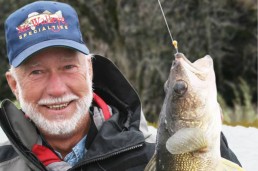Cash in on Last-minute Open-water Walleyes
SHARE THIS POST
Hard-water walleye fishing will soon be upon us, but there are still a few weeks where we can take advantage of the open-water fishing at our disposal. There are two things that make me want to hit the water this time of year. One is that you won’t have a lot of company on those prime locations because many anglers have stowed their boats in favor of a shotgun or rifle, and the second is that the big fish are biting.
I find that minnows are my first choice when it comes to baiting the hook. I’ve been relying on leeches and nightcrawlers all summer long, but now the shiners and red-tails are the only bait you’ll find in my boat.
The Roach Rig is what I’ll use to present the bait to the deep walleyes. I use a jig or crankbaits for the walleyes that are in water ten feet deep or less.
I start my search on long sand/rubble points with a jig and minnow. The walleyes won’t be schooled on this structure. They spread out over it and you’ll pick up one here and one there.
I make a long cast with the jig. When the minnow-tipped lure touches bottom, I just raise the rod tip about a foot and drag the jig before giving it a little pop and letting that lure settle to start the process over. Those shallow walleyes will suck the jig right off the bottom and many times all you feel is a slight bit of resistance. That tells you to set the hook.
On some bodies of water, a shallow point might be topped with vegetation. These are great spots too; you just need to modify your approach. When I’m fishing the sand/rubble points I like a jig with a stand-up head. For the vegetation-topped points I prefer the standard round-headed jig.
Are you enjoying this post?
You can be among the first to get the latest info on where to go, what to use and how to use it!
Position your boat right on the edge of the “vedge” and use a short pitch to the weedline. Let the jig settle to the bottom and then just ease the jig through the cabbage, coontail or milfoil. Snapping the jig when it gets hung up will strip off the minnow. If you just ease the jig out of a snag you’ll keep the bait on the hook and get more bites. A simple underhanded pitching approach with a slow retrieve is the right style on those late-season weedline walleyes.
When all of the lakes have turned over, walleyes can be anywhere in that body of water. This changes from the summer patterns where walleyes hug structure or suspend above the thermocline. Even on the deep structure the fish will be spread out, which means you catch one here and one there. The advantage of deep structure is you can see fish on the sonar.
During the late-season period, I actually find myself targeting those one or two fish I’m seeing on the screen. I’ll drop down a Roach Rig with a shiner on it and let that minnow swim and dance in front of that fish’s nose until it commits. For this presentation you need lively minnows—the livelier the bait, the better. This is why I check the minnow often and replace it if it looks like that bait is getting sluggish.
Late season is a great time for walleyes to go on a night bite. For this I like trolling a shallow-running crankbait over the rock piles and reefs. There is no secret to this type of fishing. You just long-line a crankbait straight out behind the boat and slowly troll over the tops of the rocks. It can’t get any simpler than that.
People talk about the late-season fish putting on the feedbag, but remember these fish are coldblooded creatures so their metabolism is slower now. While they may be eating, those feeding periods are sporadic. This means you might get a flurry of activity for a short time during two distinct time periods and then go hours without a bite. That’s the one drawback to late-season fishing. The bite is not something that is consistently productive all through the day, but instead it’s a flash here and a flash there. The timing of the feeding period can be consistent from one day to the next, so there can be a pattern to it. Just don’t count on consistent biting action.
Spring and summer provided good walleye fishing for me all over the country and I expect that this late-season period will be outstanding. I just need to squeeze some time in around the hunting, and you should too.
MWO
SHARE THIS POST
Did you enjoy this post?
You can be among the first to get the latest info on where to go, what to use and how to use it!
Gary Roach
MidWest Outdoors works with more than 200 outdoor experts each year, who contribute articles based on their areas of expertise. MidWest Outdoors magazine offers more fishing and hunting articles than any other publication!



